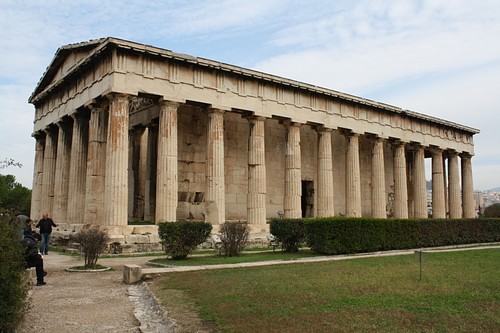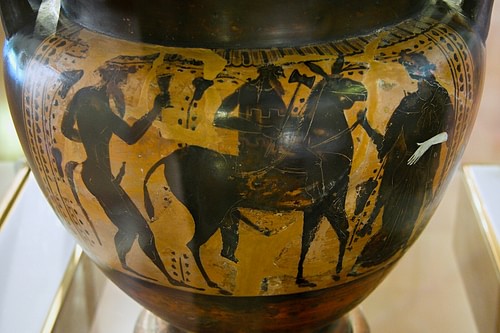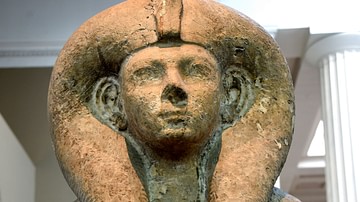
Hephaistos (Hephaestus) was the ancient Greek god of fire, metallurgy, and crafts. He was the brilliant blacksmith of the Olympian gods, for whom he fashioned magnificent houses, armour, and ingenious devices. Hephaistos had his workshop beneath volcanos such as Mount Etna on Sicily. The god had a lame foot and so he was unique as the only less-than-perfect god.
Hephaistos' Origins & Family
The origins of Hephaistos are obscure but he probably derives from the common idea that early kings should also be masters at certain crafts, especially metalwork, and perhaps, too, magic (which would have included the manipulation of fire). In Classical Greek mythology, the god was born from Hera and, without a father, Hephaistos was, unlike the other gods, a less-than-beautiful figure. So much so, that in Greek mythology he is said to have been thrown from the heavens by his mother (or in other accounts by Zeus) because of his ugliness and on landing on the island of Lemnos, the god was crippled. Cared for by Thetis (and possibly also by Eurynome, the daughter of Ocean), he would construct his workshop on the island's volcano where he lived in an imperishable bright bronze house, where he created his masterpieces of metallurgy.
The god's physical problems may have been a reflection in myth of the reality of a blacksmith's harsh working conditions where repeated hammering and toxic fumes can take their toll on both mind and body. The famed expert on Greek myths, Robert Graves, has another theory and points out that in many ancient tribes of both West Africa and Scandinavia, the village blacksmith, a particularly important and revered member of the community, was often deliberately made lame so that he could not easily offer his services to a rival village.
Hephaistos Marries Aphrodite
Returning to mythology, Hephaistos married the goddess Aphrodite. The unlikely union occurred as a result of Hephaistos capturing his mother Hera in the invisible chains of a throne he had built, and the wedding was the price of release. The scene is a popular one in Greek art and usually depicts Dionysos leading Hephaistos, under the influence of wine, back to Olympus to free the entrapped Hera. However, the marriage was not to last as Aphrodite had numerous affairs, most notably with the god Ares, although the two were caught red-handed. The whole story is told in some detail by the bard Demodocus in Book 8 of Homer's Odyssey. Hephaistos, one day informed by Helios, spied the lovers for himself and so decided to capture them next time they made misuse of his bed by designing an ingenious and invisible net of chains around it. The amorous couple, sure enough, became entwined in the golden trap, and Hephaistos then called all the Olympian gods to witness the spectacle. Roars of laughter rang around the heights of Olympus and, when finally released, Ares fled to Thrace and Aphrodite to Paphos, Cyprus.
Hephaistos' most notable offspring in Greek mythology were Erechtheus, the first king of Athens, and Periphetes, who lived near Epidaurus and famously killed passing strangers with an iron club. In Attic mythology, Hephaistos once tried to rape Athena but the goddess repelled him. The semen which splashed on her leg was wiped off, landed on earth and gave birth to the Athenians. Hephaistos also lent his name to one of the traditional tribes of Attica. Finally, to assist the god in his workshop, Hephaistos had a team of giant cyclops.
What Were Hephaistos' Skills & Associations?
As an ingenious craftsman, Hephaistos is credited with making the sceptre and aegis of Zeus, the helmet of Hermes, secret locking doors for Hera's chambers, and even the lovely first woman, Pandora, who he sculpted out of clay. He also manufactured automatons - gold maids who could speak and were intelligent - for himself, bronze Talos as a gift for King Minos of Crete, and watchdogs for Alcinous, king of Phaeacia. The god even acted as midwife at the birth of Athena, splitting Zeus' head with his axe so that the goddess might be born from there.
Both Homer and Hesiod describe Hephaistos as 'the cripple-foot god' and 'the lame one'. Supporting the Achaeans in the Trojan War, he memorably fights and defeats the river god Xanthos with fire and produces magnificent armour and a shield of bronze, gold, silver, and tin for Achilles, the latter being decorated with a multitude of scenes and described at great length by Homer.

Where Was Hephaistos Worshipped?
Hephaistos was particularly worshipped at Athens and Lemnos in the northeast Aegean. Athens had a celebrated temple jointly dedicated to god and Athena (also a patron god of crafts and their exponents); still standing on a rise in the now excavated ancient Agora, it is one of the best-preserved temples in the Greek world. The Doric temple built c. 449 BCE and sometimes known as the Hephaisteion or Thesium has 13 columns on the long sides and six at the facades. The temple originally contained large bronze statues of Athena and Hephaistos. According to Sophocles, blacksmiths would march through the city carrying their tools during the annual Chalkeia festival which honoured the pair of gods. The even more spectacular Hephaestia festival was held in Athens only once every five years and involved torchlight parades and extravagant sacrifices to honour Athena and Hephaistos.
At Lemnos, meanwhile, where, as we have seen, the god was thrown to earth in some accounts, Hephaistos gave his name to the city of Hephaistia, which had a sanctuary dedicated to him. Certain landmarks on the island were linked to the god and his craft such as the bay at Mudros (meaning 'mass of molten metal'). Even the earth of the island was exported in antiquity as people believed it had qualities as both a cure and poison. Other sites where Hephaistos was revered and often associated with naturally-occurring fires included Caria and Lycia. Agrigento on Sicily once had an important temple dedicated to the god (c. 430 BCE), although there are today few remains of it. Finally, as the god was thought to have his workshop beneath volcanos he was linked to many, but especially Mount Aetna (Etna) on Sicily.
How Was Hephaistos Represented in Art?
In ancient Greek art, Hephaistos is often depicted wearing a pilos or workman's hat and an exomis or workman's tunic. He also often holds tongs, an axe, hammer, saw, or chisel, and is frequently seen riding a mule side-saddle. The latter depiction is in reference to his lameness which, curiously, is rarely explicitly portrayed in Greek art. In a few Attic vases the god's feet are shown pointing backwards. He is a prominent figure on the east pediment of the Parthenon (447-432 BCE) where the scene of Athena's birth is shown. This mythological subject was also popular on Attic pottery where Hephaistos, with his axe, splits the head of Zeus from where Athena is born. The east frieze of the Parthenon shows all the gods of Olympus in a row watching the city's Panathenaic procession with Athena and Hephaistos, the two patrons of the crafts, sat next to each other chatting.






